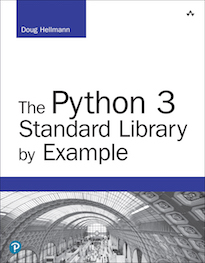Developer Tools¶
Over the course of its lifetime, Python has evolved an extensive ecosystem of modules intended to make the lives of Python developers easier by eliminating the need to build everything from scratch. That same philosophy has been applied to the tools developers use to do their work, even if they are not used in the final version of a program. This chapter covers the modules included with Python to provide facilities for common development tasks such as testing, debugging, and profiling.
The most basic form of help for a developer is the documentation for
code they are using. The pydoc module generates formatted
reference documentation from the docstrings included in the source
code for any importable module.
Python includes two testing frameworks for automatically exercising
code and verifying that it works correctly. doctest extracts
test scenarios from examples included in documentation, either inside
the source or as stand-alone files. unittest is a
full-featured automated testing framework with support for fixtures,
pre-defined test suites, and test discovery.
The trace module monitors the way Python executes a program,
producing a report showing how many times each line was run. That
information can be used to find code paths that are not being tested
by an automated test suite, and to study the function call graph to
find dependencies between modules.
Writing and running tests will uncover problems in most programs.
Python helps make debugging easier, since in most cases unhandled
errors are printed to the console as tracebacks. When a program is
not running in a text console environment, traceback can be
used to prepare similar output for a log file or message dialog. For
situations where a standard traceback does not provide enough
information, use cgitb to see details like local variable
settings at each level of the stack and source context. cgitb
can also format tracebacks in HTML, for reporting errors in web
applications.
Once the location of a problem is identified, stepping through the
code using the interactive debugger in the pdb module can make
it easier to fix by showing what path through the code was followed to
get to the error situation, and experimenting with changes using live
objects and code.
After a program is tested and debugged so that it works correctly, the
next step is to work on performance. Using profile and
timeit, a developer can measure the speed of a program and find
the slow parts so they can be isolated and improved.
It is important to indent source code consistently in a langauge like
Python, where white-space is significant. The tabnanny module
provides a scanner to report on ambiguous use of indentation, and
can be used in tests to ensure that code meets a minimum standard
before it is checked in to the source repository.
Python programs are run by giving the interpreter a byte-compiled
version of the original program source. The byte-compiled versions
can be created on-the-fly, or once when the program is packaged. The
compileall module exposes the interface used by installation
programs and packaging tools to create files containing the byte code
for a module. It can be used in a development environment to make
sure a file does not have any syntax errors and to build the
byte-compiled files to package when the program is released.
At the source code level, the pyclbr module provides a class
browser that can be used by a text editor or other program to scan
Python source for interesting symbols such as functions and classes,
without importing the code and potentially triggering side-effects.
Python virtual environments, managed by venv, define isolated
environments for installing packages and running programs. They make
it easy to test the same program with different versions of
dependencies, and to install different programs with conflicting
dependencies on the same computer.
Taking advantage of the large ecosystem of extension modules,
frameworks, and tools available through the Python Package Index
requires a package installer. Python’s package installer, pip, is not
distributed with the interpreter, because of the long release cycle
for the language compared to desired updates to the tool. The
ensurepip module can be used to install the latest version of
pip.
- pydoc — Online Help for Modules
- doctest — Testing Through Documentation
- unittest — Automated Testing Framework
- trace — Follow Program Flow
- traceback — Exceptions and Stack Traces
- cgitb — Detailed Traceback Reports
- pdb — Interactive Debugger
- profile and pstats — Performance Analysis
- timeit — Time the execution of small bits of Python code.
- tabnanny — Indentation validator
- compileall — Byte-compile Source Files
- pyclbr — Class Browser
- venv — Create Virtual Environments
- ensurepip — Install the Python Package Installer
 PyMOTW-3
PyMOTW-3